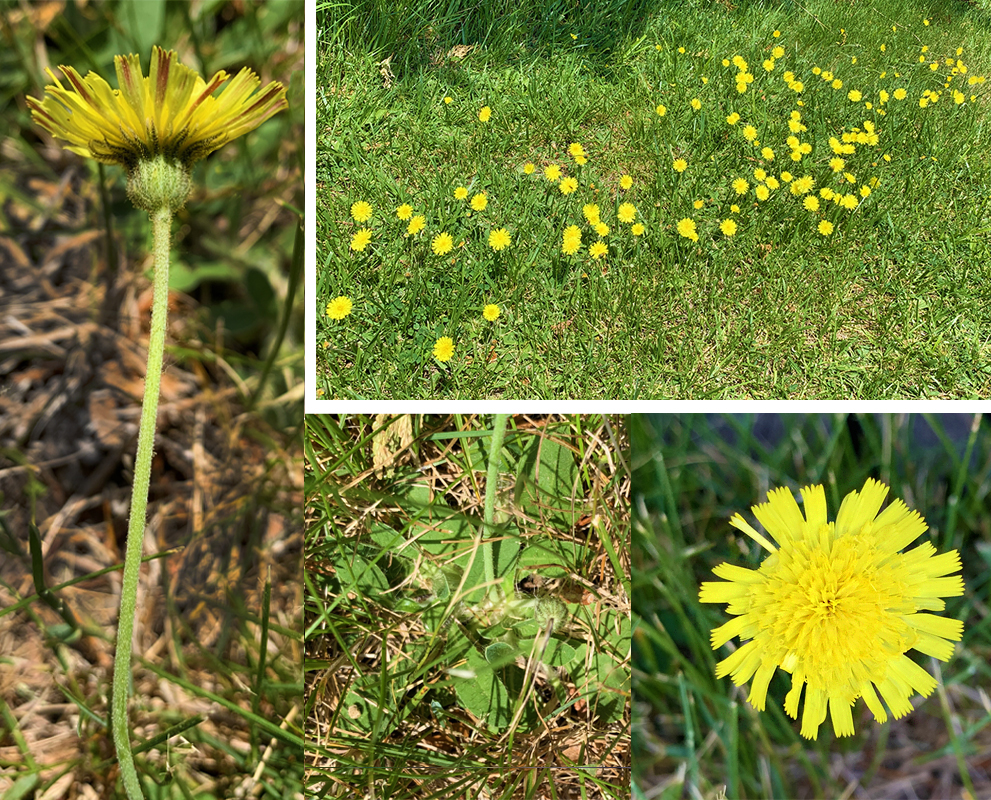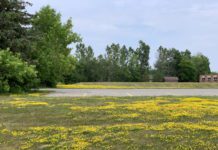by Fred Schueler, Fragile Inheritance Natural
History
Back in 2020, I wrote up the way low-growing varieties of Lotus corniculatus, Bird’s-foot Trefoil, were spreading yellow patches of bloom onto many midsummer local lawns (North Grenville Times, 5 August 2020 – https://ngtimes.ca/golden-spangled-lawns/).
Dandelions of course do this in the early spring, and this June a Dandelion-like flower is providing either a scattering of bloom or dense patches on many local lawns. I’ve seen this species for many years, especially on July trips to Almonte, but have only started to attend to it now as it’s becoming more widespread in North Grenville. This is Pilosella officinarum, Mouse-ear Hawkweed, which is native to Europe and northern Asia. The blooms are dandelion-like, but a bright lemon-yellow colour and the flower rays are toothed at their ends. The small leaves are untoothed and hairy. I’d previously noticed it in 1996 near Almonte, where there were fields in “retina-altering lemon-meringue-yellow bloom.” Unlike the single plants of Dandelions, Mouse-ear has spreading stems which grow out into circular patches, and with its low flat leaves, is credited with being able to exclude most other plants.

The species seems to have first shown up in Canada in the 19th Century on Prince Edward Island, then to have spread to the other Atlantic provinces, then into Quebec and later Ontario. Its patchy distribution is probably due to the prickly seeds hitching rides in the fur of mammals (and human clothing and artifacts), rather than spreading on wind-borne fluff, as Dandelions do.
This spring, we’ve seen lots of Mouse-ears along Stagecoach Road south of Ottawa, and along the New Dublin Road north of Brockville, but there have been long trips where we haven’t noticed any. Locally, there’s quite a lot along County Road 18 south of Oxford Mills. Joyce Cook, SW of Bishops Mills, has dense patches on her lawn which she noticed this year for the first time, and Matt Keevil outside Oxford Mills has “some and it seems to be on the increase.” There are a few plants on the lawn of the Pentecostal Church adjacent to our lawn in Bishops Mills, and a small patch by the driveway culvert of the daughter’s place on Cranberry Crescent in Kemptville, so it will be interesting to see how these spread in future years.
Mouse-ears are “highly variable and… a member of a species complex of several dozens of subspecies and hundreds of varieties and forms” (Wikipedia), so there’s lots of variation from which ground-hugging forms could be selected. After I wrote about the low forms of Birds-foot Trefoil in 2020, the Field Botanists facebook page pointed out that in addition to the well-known White Clover (Trifolium repens), other species have adapted to bloom with short stems on mowed lawns, including Heal-all (Prunella vulgaris) and Black Medick (Medicago lupulina).
Because lawns cover so much of the landscape, there is intense natural selection for species to develop low forms to grow and flower there, especially since the 2009 Ontario ban on recreational herbicides. In years to come, we can expect more species to make this adaptation, making lawns more visually interesting, and providing resources for pollinating insects. The yellow blooms on the lawn of South Nation Conservation in Finch, for example, are Buttercups (Ranaculus) poking their blooms a few centimetres above prostrate plants.







The original article is Schueler, Fred. 2020. Golden-Spangled Lawns. North Grenville Times, 5 August 2020. https://ngtimes.ca/golden-spangled-lawns/ (photo by Aleta Karstad)